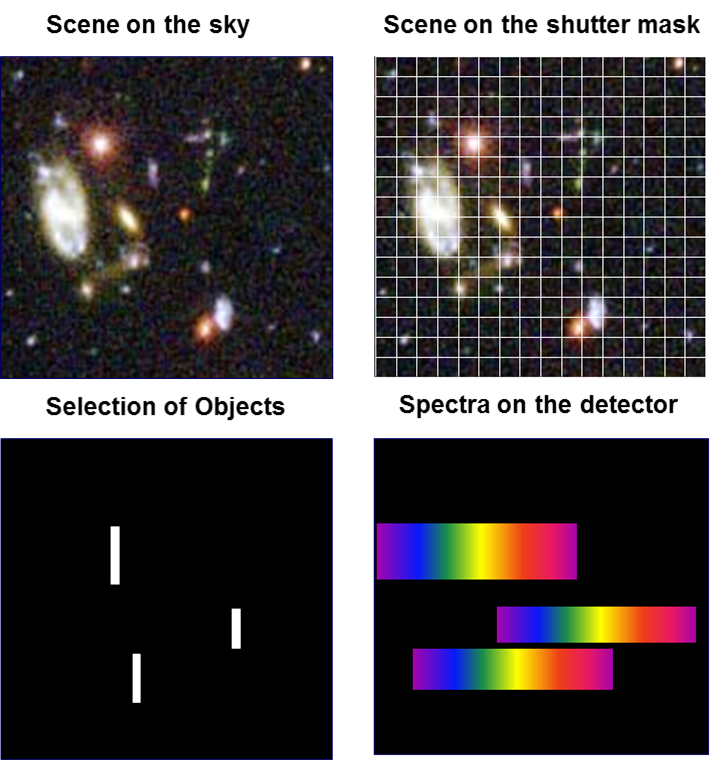Multi-Object Spectrometer on:
[Wikipedia]
[Google]
[Amazon]
 A multi-object spectrometer is a type of
A multi-object spectrometer is a type of
 A multi-object spectrometer is a type of
A multi-object spectrometer is a type of optical spectrometer
An optical spectrometer (spectrophotometer, spectrograph or spectroscope) is an instrument used to measure properties of light over a specific portion of the electromagnetic spectrum, typically used in spectroscopic analysis to identify mate ...
capable of simultaneously acquiring the spectra of multiple separate objects in its field of view
The field of view (FOV) is the angle, angular extent of the observable world that is visual perception, seen at any given moment. In the case of optical instruments or sensors, it is a solid angle through which a detector is sensitive to elec ...
. It is used in astronomical spectroscopy
Astronomical spectroscopy is the study of astronomy using the techniques of spectroscopy to measure the electromagnetic spectrum, spectrum of electromagnetic radiation, including Visible light astronomy, visible light, Ultraviolet astronomy, ultr ...
and is related to long-slit spectroscopy. This technique became available in the 1980s.
Description
The term multi-object spectrograph is commonly used for spectrographs using a bundle offibers
Fiber (spelled fibre in British English; from ) is a natural or artificial substance that is significantly longer than it is wide. Fibers are often used in the manufacture of other materials. The strongest engineering materials often inco ...
to image part of the field. The entrance of the fibers is at the focal plane of the imaging instrument. The bundle is then reshaped; the individual fibers are aligned at the entrance slit of a spectrometer, dispersing the light on a detector.
This technique is closely related to integral field spectrography (IFS), more specifically to fiber-IFS. It is a form of snapshot hyperspectral imaging, itself a part of imaging spectroscopy
Imaging is the representation or reproduction of an object's form; especially a visual representation (i.e., the formation of an image).
Imaging technology is the application of materials and methods to create, preserve, or duplicate images.
...
.
Apertures
Typically, the apertures of multi-object spectrographs can be modified to fit the needs of the given observation. For example, the MOSFIRE (Multi-Object Spectrometer for Infra-Red Exploration ) instrument on the W. M. Keck Observatory contains the Configurable Slit Unit (CSU) allowing arbitrary positioning of up to forty-six 18 cm slits by moving opposable bars. Some fiber-fed spectroscopes, such as the Large Sky Area Multi-Object Fibre Spectroscopic Telescope (LAMOST) can move the fibers to desired position. The LAMOST moves its 4000 fibers separately within designated areas for the requirements of a measurement, and can correct positioning errors in real time. TheJames Webb Space Telescope
The James Webb Space Telescope (JWST) is a space telescope designed to conduct infrared astronomy. As the largest telescope in space, it is equipped with high-resolution and high-sensitivity instruments, allowing it to view objects too old, Lis ...
uses a fixed Micro-Shutter Assembly (MSA), an array of nearly 250000 5.1 mm by 11.7 mm shutters that can independently be opened or closed to change the location of the open slits on the device.
Uses in telescopes
Ground-based instruments
Instruments with multi-object spectrometry capabilities are available on most 8-10 meter-class ground-based observatories. For example, theLarge Binocular Telescope
The Large Binocular Telescope (LBT) is an optical telescope for astronomy located on Mount Graham, in the Pinaleno Mountains of southeastern Arizona, United States. It is a part of the Mount Graham International Observatory.
When using both ...
, W. M. Keck Observatory, Gran Telescopio Canarias
The Gran Telescopio Canarias (GranTeCan or GTC) is a reflecting telescope located at the Roque de los Muchachos Observatory on the island of La Palma, in the Canary Islands, Spain. It is the List of largest optical reflecting telescopes, world's ...
, Gemini Observatory
The Gemini Observatory comprises two 8.1-metre (26.6 ft) telescopes, Gemini North and Gemini South, situated in Hawaii and Chile, respectively. These twin telescopes offer extensive coverage of the northern and southern skies and rank among ...
, New Technology Telescope
The New Technology Telescope or NTT is a 3.58-metre Ritchey–Chrétien telescope operated by the European Southern Observatory. It began operations in 1989. It is located in Chile at the La Silla Observatory and was an early pioneer in the us ...
, William Herschel Telescope
The William Herschel Telescope (WHT) is a optical and near-infrared reflecting telescope located at the Roque de los Muchachos Observatory on the island of La Palma in the Canary Islands, Spain. The telescope, which is named after William Hersc ...
, UK Schmidt Telescope
The UK Schmidt Telescope (UKST) is a 1.24 metre Schmidt telescope operated by the Australian Astronomical Observatory (formerly the Anglo-Australian Observatory); it is located adjacent to the 3.9 metre Anglo-Australian Telescope at ...
and LAMOST include such system.
Four instruments in the Very Large Telescope
The Very Large Telescope (VLT) is an astronomical facility operated since 1998 by the European Southern Observatory, located on Cerro Paranal in the Atacama Desert of northern Chile. It consists of four individual telescopes, each equipped with ...
, including the KMOS (K-band multi-object spectrograph) and the VIMOS (Visible Multi Object Spectrograph) instruments, have multi-object spectroscopic capabilities.
Space-based instruments
TheHubble Space Telescope
The Hubble Space Telescope (HST or Hubble) is a space telescope that was launched into low Earth orbit in 1990 and remains in operation. It was not the Orbiting Solar Observatory, first space telescope, but it is one of the largest and most ...
has been operating the NICMOS (Near Infrared Camera and Multi-Object Spectrometer) from 1997 to 1999 and from 2002 to 2008.
The James Webb Space Telescope
The James Webb Space Telescope (JWST) is a space telescope designed to conduct infrared astronomy. As the largest telescope in space, it is equipped with high-resolution and high-sensitivity instruments, allowing it to view objects too old, Lis ...
's NIRSpec (Near-Infrared Spectrograph) instrument is a multi-object spectrometer.
References
{{reflist Observational astronomy Astronomical spectroscopy